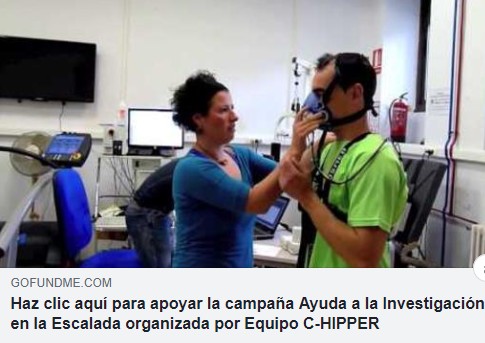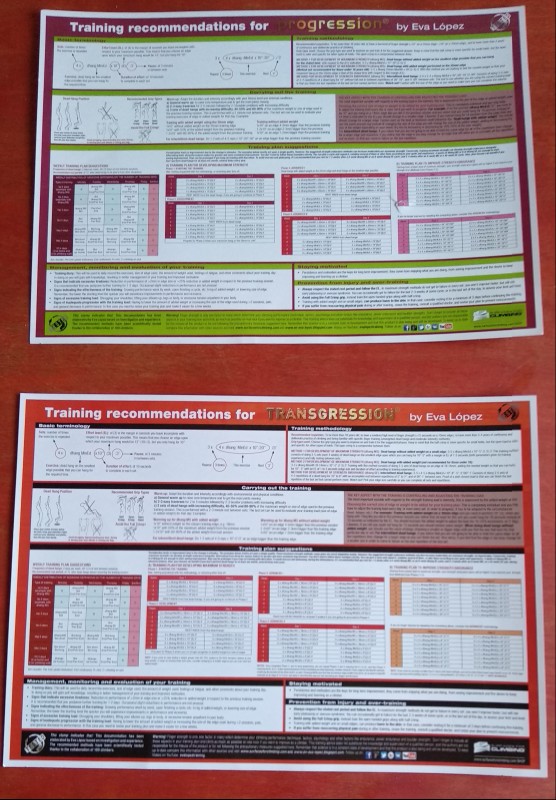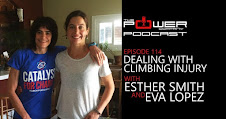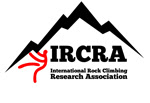Versión en español
As it was hinted in the previous entry, to perform at certain routes or climbing spots we need to train one kind of endurance that French climbers call continuité (continuidad in Spanish), and in the English-speaking world is called endurance, stamina or local aerobic endurance; I will explain later on why I prefer the latter.
What are we talking about? A definition of Local Aerobic Endurance
 |
| Could this forearm belong to someone who is working their local aerobic endurance? Keep reading and find out... |
- Recover from one try to a route to the next, and also at resting points during a climb
- Climb long, easy-medium intensity sections without getting overly pumped
- Climb a long route, climb a lot of routes or try the same route several times during one day.
The routes we tend to associate with this quality lack a very hard crux and are usually long. For example, they are 25-30+m long, have 60-80 moves or take more than 20 minutes to ascend even when we know the moves.
Local Aerobic Endurance and Energy Systems
Attending to its main metabolic source of energy, long duration and low intensity, some authors place it within aerobic endurance, that relies on the oxidative system. Others go a bit further and point the low volume of muscle that is involved (less than 1/6-1/7 of the total). So they use the -more accurate- term local aerobic endurance or local aerobic-anaerobic endurance.
We still have to acknowledge one fact: it is possible to deduce what the main energy source is for a given section of a climb, attending to several factors (hold depth, overhang angle, speed, duration, etc.). But sport climbing as an aggregate is an intermittent sport; there is movement and there are stops, there are easy and hard segments, there is holding and releasing... this makes for an assortment of metabolic and physiologic characteristics. Among them, anaerobic alactic and aerobic metabolism (Bertucci et col., 2007), are the most important.
 |
| Chart adapted from Guidi (1999) |
Why does the 'local' qualifier make the term more accurate? Because it reminds us that the criteria that are useful when dealing with other sports of similar duration to indoor competitive climbing (like running 1500 or 3000m) or onsighting a rock route (like running 10k or swimming 1500m) are not applicable to sport climbing.
The reason is that those sports involve a big (more than 1/6 of the total) volume of muscle, and the load they have to displace represents a low percent of the maximum strength of the implicated muscles. One consequence is the need for an increased blood flow. Therefore, cardiovascular endurance, also known as aerobic power (measured through maximal oxygen uptake -VO2max-) and aerobic capacity (performance at or close to lactate threshold) are more relevant than the local or muscular factors.
Physiological Demands of Sport Climbing
In fact, during progressive climbing sets (steepness) in a treadwall (Schöffl et col., 2006) no point was found after which lactate accumulated exponentially as it happens in other sports: the increase was merely linear. These authors concluded that blood lactate can show the evolution of a climber in a given route, but we can't talk about a 'lactate threshold' per se. It can be argued that these results may vary if reducing hold size was used as the way to increase difficulty instead of running the treadwall faster or steeper... anyway: given the small absolute amounts of lactate measured and the particular characteristics of our fatigue (that can't be explained by acidosis alone), it could be even more fitting to talk about 'local fatigue threshold' (term coined in honor to the interesting conversations with my colleague P. Bergua) than about 'lactate threshold'.
 |
| Luis Alfonso Félix on Palestina, 9a (Cuenca). Photo: Javipec |
Summing up: Climbing is an intermittent sport that involves a lot of isometric action of small muscles that have to bear most of the body's mass, and these realizations are capital for understanding fatigue and developing training methods accordingly.
 |
| Andrea Cartas training at Kletterhallewien (Vienna). Photo: Carlos Padilla |
We can't use blood lactate, heart rate or VO2max to evaluate or choose a training method, because these parameters have not been shown to be representative of intensity in climbing (Koestermeyer, 2000; Michailov 2002; Schöffl et col. 2006; Burnik and Jereb, 2007). Then, what factor do we use to train not only local aerobic endurance, but also other forms of endurance?
Intensity will be a function of what fraction of our maximum strength we need to grab a hold (given by its depth, shape, texture...) along with grip duration (a function of foot- and handhold distribution, clipping points...) in a given route (steepness, etc.) (López-Rivera, 2014).The logical conclusion is that we need to choose holds of a size that allows us to maintain the activity and sensations associated to local aerobic endurance for the required time on a climbing surface (with its own overhang, hold distribution, etc.).
Planning for Local Aerobic Endurance: Bases
We usually hear about high volume and low intensity training, with many sets of easy, homogeneous climbing and short rests, or climbing many rock routes in a day, etc.
We are not going to discuss here some popular methods (like 4x4's) or other methods put forward by different authors. We won't learn how to train local aerobic endurance in general, because I believe it to be too simplistic.
What we are going to do is reviewing what I think are the 3 specific goals or the 3 aspects that determine the training of this quality.
Why?
Training your Local Aerobic Endurance: Goals
GOAL #1: Make our forearms capable of completing a climb without getting 'depleted'.
In other words, enhancing CAPACITY, also known among climbers as ARC (aerobic energy restoration and capillarity)
 |
| Chris Sharma on "Jumbo Love", 9b. Clark Mountain (USA). Photo: Boone Speed. Source: www.petzl.com |
GOAL #2: To be able to conserve our strength through long, low- to mid-intensity sections.
To put it another way: reducing fatigue and pumped forearms on easier parts, no matter their length.
We can refer to this goal as STEADY-STATE (negotiating moderate intensity-medium duration sections), or EFFICIENCY or economy of movement (okay, we are venturing into the realm of technique, but who says these things are unrelated?)
 |
| Emily Harrington - Red River Gorge - Photo: Keith Ladzinski - Source: http://flickr.com |
GOAL #3: ABILITY TO RECOVER
This quality is a requirement of the heterogeneous and intermittent nature of rock climbing, and there are several reasons why this can determine performance:
- Reducing the time spent resting shortens effective climbing time, which influences energy economy, efficiency and capacity.
- It takes less time to recover from hard moves, not only at good rests, but also while moving, when we shake our free arm, or even while chalking up! Our chances will improve when facing the crux because of the fast phosphagen repletion (an energy substrate for high intensity efforts), optimal oxygenation and recycling-elimination of fatigue-related metabolites. We will also be able to give the same route more tries during one day.
 |
| Brent Perkins on Proper Soul, 5.14a - Picture:Taylor Strohmeyer. Source: http://brentperkins30.blogspot.com/ |
General guidelines for goal-based periodization according to level and training phase
We need to take into account the characteristics of our project (distribution of hard moves, steepness, length), our climbing level, training experience and personal qualities; these will inform your choice of goals, which one to prioritize, or even why you must ignore all of them for the time being! Always keep in mind the training principles of individualization and specificity.
LOWER LEVELS: Earlier training stages and Beginners
At this stage we will focus on Goal #1, because when we start training or climbing we tend to lack enough capacity (Bertuzzi et col., 2007), probable due to poor technique and low finger strength. Some telling signs of insufficient capacity are getting exhausted before sorting all the moves of a route in one try, having limited 'energy' to climb several routes even if they are easy or familiar and getting pumped too soon.
 |
| Edu Marín on"A muerte", 8c+/9a. Siurana. Photo: Israel Macià. Source:www.desnivel.com |
Once the previous stage is taken care of, it is possible to begin training for Goal #2. Here we will develop our Efficiency, meaning the ability to climb at low-mid intensity without getting too pumped, or feeling pain or stiffness in our forearms.
HIGHER LEVELS
Advanced climbers, once they have addressed the previous goals both through their sport career and during the season, can proceed to methods aimed to achieving Goal #3, being able to recover their forearms in record time, while climbing and also from route to route.
 |
| Eva López on Géminis, 8b+. Rodellar. Photo: Dafnis Fernández |
This said, I need to remind everyone that we can't ignore other qualities: boulder, finger strength, etc. We also have to choose our goals and associated methods for each of them.
The description of the different training methods that are indicated for the fulfillment of each Goal will be the topic of the next entries.
RELATED ENTRIES:
why we need to train our Local Aerobic Endurance: the numbers speak
RECOMMENDED READINGS TO EXPAND AND IMPROVE YOUR KNOWLEDGE
- Bechtel, S. Unlearning Endurance Training, in website: "Climb Strong"[on-line], entry from January 21th, 2013. Available at: http://www.climbstrong.com/articles/20130121_12
- Goddard, D., y Neumann, U. (1993). Performance rock climbing. Stackpole Books. (105-106)
- MacLeod, D. (2010). 9 out of 10 climbers make the same mistakes: navigation through the maze of advice for the self-coached climber. Rare Breed Productions. (pág 85-86)
- Baláš, J., Panáčková, M., Strejcová, B., Martin, A. J., Cochrane, D. J., Kaláb, M., ... and Draper, N. (2014). The Relationship between Climbing Ability and Physiological Responses to Rock Climbing. The Scientific World Journal
- Bertuzzi, R. C., Franchini, E., Kokubun, E., and Kiss, M. (2007). Energy system contributions in indoor rock climbing. European journal of applied physiology, 101(3), 293-300.
- Billat, V., Palleja, P., Charlaix, T., Rizzardo, P., and Janel, N. (1995). Energy specificity of rock climbing and aerobic capacity in competitive sport rock climbers. Journal of Sports Medicine and Physical Fitness, 35(1), 20-24
- Booth, J., Marino, F., Hill, C., and Gwinn, T. (1999). Energy cost of sport rock climbing in elite performers. British Journal of Sports Medicine, 33(1), 14-18.
- Burnik, S., and Jereb, B. (2009). Heart rate as an indicator of sport climbing intensity. Acta Universitatis Palackianae Olomucensis. Gymnica, 37(1), 63-66
- de Geus, B., O’Driscoll, S. V., and Meeusen, R. (2006). Influence of climbing style on physiological responses during indoor rock climbing on routes with the same difficulty. European journal of applied physiology, 98(5), 489-496.
- España-Romero, V., Porcel, F. B. O., Artero, E. G., Jiménez-Pavón, D., Sainz, A. G., Garzón, M. J. C., and Ruiz, J. R. (2009). Climbing time to exhaustion is a determinant of climbing performance in high-level sport climbers. European journal of applied physiology, 107(5), 517-525.
- Guidi, O. (1999). Les filières énergétiques en escalade. Revue education physique et sport, 276:15-19.
- Köstermeyer, G. (2000). Strength endurance training for elite rock climbers. High Performance seminar por British Mountaineering Council, Plas y Brenin (Wales, UK)
- Lehner, C. (2000). Etude de l’intervention relative des differentes filiêres énergétiques en escalade sportive. Sport Belgique. 170:12-20.
- López-Rivera, E. (2014): Efectos de Diferentes Métodos de Entrenamiento de Fuerza y Resistencia de Agarre en Escaladores Deportivos de distintos Niveles (Doctoral Thesis, unpublished). Programa de Doctorado en Rendimiento Deportivo, Universidad de Castilla-La Mancha, Toledo, España.
- Michailov, M.L., (2002). Difficulties controlling the training load in sport climbing. In: Sports, Society, Education, Vol 8. Sofia: Tiptoppres: 253-258.
- Schöffl, V. R., Möckel, F., Köstermeyer, G., Roloff, I., and Küpper, T. (2006). Development of a performance diagnosis of the anaerobic strength endurance of the forearm flexor muscles in sport climbing. International journal of sports medicine, 27(03), 205-211.
- Watts, P. B. (2004). Physiology of difficult rock climbing. European journal of applied physiology, 91(4), 361-372






 https://orcid.org/0000-0003-0304-5290
https://orcid.org/0000-0003-0304-5290








No comments:
Post a Comment
SOME RULES FOR YOUR COMMENTS:
- Please try to choose the most suitable section for your new comment. In general, ask questions that you think is on-topic.
- Only one question per comment and please try to keep your inquiries relatively short and reasonably scoped. Otherwise, it often makes the thread hard to read.
- Please avoid: How should I train for..., What's wrong with my finger?
- Please, don't use this blog to advertise products or services.
Thank you for your understanding